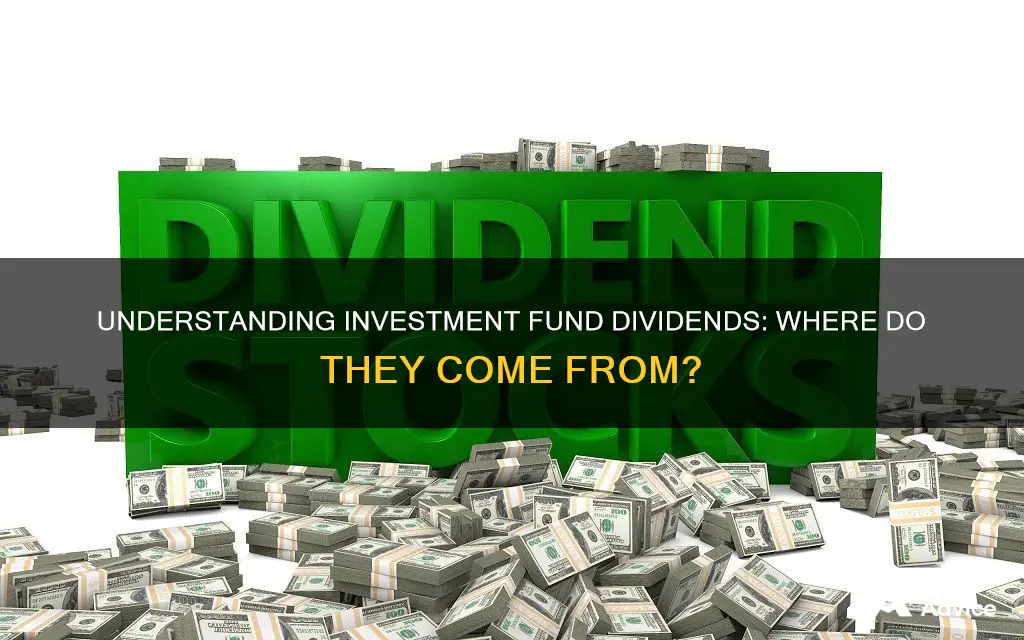
Dividends are a portion of a company's profits paid to investors who own a company's stock. They are distributed on a regular basis, typically quarterly, monthly, or annually. Dividends are not guaranteed and not all companies pay them. Companies that do pay dividends are generally financially stable, and dividends are seen as an indication of a company's financial health. Dividends can be paid out in cash or as additional shares. They are taxable, and the tax rate depends on the investor's tax bracket and how long they have owned the shares. Dividend-paying stocks are considered attractive investments because they provide a regular income stream and offer some protection in volatile markets.
| Characteristics | Values |
|---|---|
| Definition | A distribution made by a company to its shareholders—normally common shareholders. |
| Payment Type | Cash or additional shares |
| Payment Frequency | Monthly, quarterly, semi-annually, annually |
| Taxation | All types of dividends are taxable. Qualified dividends are taxed at lower long-term capital gains rates, while non-qualified dividends are taxed at ordinary income tax rates. |
| Companies Paying Dividends | Larger, established companies with predictable profits, such as those in the healthcare, pharmaceuticals, and real estate sectors. |
| Companies Not Paying Dividends | Young, fast-growing companies in sectors like technology and biotechnology. |
| Impact on Stock Price | A stock's share price will change to reflect a dividend payment. |
| Investor Profile | Dividend-paying stocks are attractive to investors seeking stable income and low volatility. |
What You'll Learn

Dividends as a source of income
Dividends are a percentage of a company's profits paid to its shareholders. They are distributed on a regular basis, typically quarterly, but also monthly or annually. Dividends are not guaranteed, and not all companies pay them. They are usually offered by more established corporations, and they are often seen as a sign of financial health and stability.
Dividends can be paid out in cash or additional shares. When a company announces a dividend, it also announces the payment date on which the dividend will be paid into the shareholders' accounts. The amount of the dividend is decided by the company's board of directors based on the company's most recent earnings.
Dividends can provide investors with a regular income stream, and they can be particularly useful when markets are volatile. They can also help to lower volatility and buffer losses during market downturns. Dividend-paying stocks can be a good option for investors seeking income and stability rather than high growth potential.
Dividend-paying mutual funds are another option for investors seeking dividend income. These funds aggregate the dividend income from multiple stocks and pay dividends to investors after fees. Mutual funds that follow a dividend reinvestment plan (DRIP) reinvest the received dividend amount back into the stocks, while others follow a dividend payment plan by aggregating dividend income and making periodic payments to account holders.
When investing in dividend-paying stocks or mutual funds, it is important to consider the tax implications, as dividends are typically taxable. The tax treatment of dividends can vary depending on the investor's jurisdiction and how long they have owned the shares.
Mutual Fund Money: Strategies for Success
You may want to see also

Dividend yield and how it's calculated
Dividend yield is a ratio that helps investors understand how much return they are getting on their investment. It is the amount of money a company pays shareholders for owning a share of its stock, divided by its current stock price. This is usually calculated on a per-share basis. Dividends are generally paid on a per-share basis. If you own 100 shares of a company, these 100 shares are the basis for your dividend distribution.
The formula for calculating dividend yield is:
> Dividend Yield (%) = Dividend Per Share (DPS) / Current Share Price
For example, if a company is trading at $10.00 on the market and issues an annual dividend per share (DPS) of $1.00, the company's dividend yield is equal to 10%.
Dividend yield can be calculated from the last full year's financial report, or by adding the last four quarters of dividends, which captures the trailing 12 months of dividend data. It is important to note that dividend yield is usually calculated annually, even though dividends are paid quarterly. This is because not all companies pay an even quarterly dividend, and calculating the dividend yield annually gives a more accurate result.
Dividend yield is an important metric for investors as it helps them understand how much cash flow they are getting for every dollar they have invested in a company.
Lumpsum Mutual Fund Investment: Is It Worth the Risk?
You may want to see also

Dividend payout ratio
Dividends are a distribution of a company's earnings to eligible shareholders. They are generally paid quarterly, with the amount decided by the board of directors.
The dividend payout ratio is a key financial metric used to determine the sustainability of a company's dividend payment program. It is the total amount of dividends paid to shareholders relative to the company's net income. It is sometimes referred to simply as the "payout ratio".
The dividend payout ratio is calculated by dividing the dividend amount by net income for the same period. This can be done on a per-share basis by dividing the dividends per share by the earnings per share. The payout ratio can also be calculated as one minus the retention ratio, which is the percentage of net income that is kept by the company as retained earnings.
The dividend payout ratio is 0% for companies that do not pay dividends and 100% for companies that pay out their entire net income as dividends. A high payout ratio is generally considered risky, as a fall in earnings may lead to a dividend cut and a resulting fall in the share price. A low payout ratio may indicate the potential for dividends to increase in the future, or it may mean that the stock has low yields.
The dividend payout ratio is influenced by the company's level of maturity. A new, growth-oriented company aiming to expand is likely to reinvest most or all of its earnings and may have a low or zero payout ratio. An older, established company, on the other hand, may aim to return more to shareholders and could face pressure to increase its payout ratio.
The dividend payout ratio is also useful for assessing the sustainability of a company's dividend payments. A payout ratio of over 100% indicates that a company has returned more money to shareholders than it has earned, and it may be forced to lower or stop paying dividends altogether.
The retention ratio is the opposite of the dividend payout ratio, representing the percentage of profits earned that are retained by or reinvested in the company.
Dividend payouts vary by industry and are most useful when compared within a given industry. For example, real estate investment trusts (REITs) are legally required to distribute at least 90% of their earnings to shareholders, while master limited partnerships (MLPs) also tend to have high payout ratios.
Hedge Funds: A Smart Investment for the Current Market
You may want to see also

Dividend coverage ratio
Dividends are the percentage of a company's profits that are paid out to its shareholders. They are usually paid out quarterly, though they can also be paid out annually or monthly.
The dividend coverage ratio (DCR) is a financial metric that measures a company's ability to pay dividends to its shareholders. It is calculated by dividing a company's net income by the dividends it pays out. A higher ratio is more favourable, indicating that a company can afford to pay dividends to its shareholders. A DCR above 2 is considered healthy, while a DCR below 1.5 may be a cause for concern.
Net income refers to the earnings a company makes after all expenses, including taxes, have been paid. Dividend declared refers to the amount of dividend to which shareholders are entitled.
It is important to note that the dividend coverage ratio has some limitations as a metric. Net income can vary significantly from year to year, so a high historical DCR may not be a reliable indicator of future dividend risk. Additionally, net income does not always equal cash flow, so a company with a high net income may not have sufficient cash available to make dividend payments.
A Beginner's Guide to USAA Mutual Fund Investing
You may want to see also

Dividend growth rate
There are several methods for calculating DGR. The simplest way is to take the current dividend per share and divide it by the dividend per share from the previous period. This will give you the DGR for that period. For example, if a company's current dividend per share is $1, and the previous dividend per share was 50 cents, the DGR would be 100%. This means the company's dividend payments have doubled over the period.
Another method is to calculate the compound annual growth rate (CAGR). This takes into account the dividend growth rates over multiple periods. To calculate CAGR, you divide the current dividend per share by the dividend per share from the beginning of the period. Then, you take the result and raise it to the power of one divided by the number of periods. For example, if a company has increased its dividend per share from 50 cents to $1 over three years, you would divide $1 by 50 cents, then raise the answer to the power of one-third (as there were three years), giving you a CAGR of 8.2%.
DGR is an important variable in the dividend discount model (DDM), which is used to predict the price of a company's stock based on the theory that its present-day price is worth the sum of all its future dividend payments when discounted back to their present value. The DDM attempts to calculate the fair value of a stock, irrespective of the prevailing market conditions.
UTI Transportation and Logistics Fund: Worth the Investment?
You may want to see also
Frequently asked questions
Dividends are a distribution of a company's earnings to eligible shareholders. They are typically paid out quarterly as cash payouts, but can also be issued as shares of stock. Not all companies pay dividends.
The dividend yield is calculated as: Dividend Yield = Dividend/Price x 100. So, if you own 100 shares of a company that pays out $10 per share annually in dividends, and you paid $100 per share, your dividend yield would be 10%.
Dividends are paid out on a predetermined schedule, typically quarterly, but sometimes annually or semi-annually. The company's board of directors must first approve a plan to share profits in the form of a dividend. The company then announces when the dividend will be paid, the amount, and the ex-dividend date (the date by which investors must have purchased the stock in order to receive the dividend). Finally, the company pays out the dividend to its shareholders.
Dividends are more likely to be paid by well-established companies that no longer need to reinvest as much money back into their business. As a result, stocks that pay dividends can provide a stable and growing income stream. Examples of companies that pay dividends include Exxon, Target, IBM, Sherwin-Williams Co., and Johnson & Johnson.







